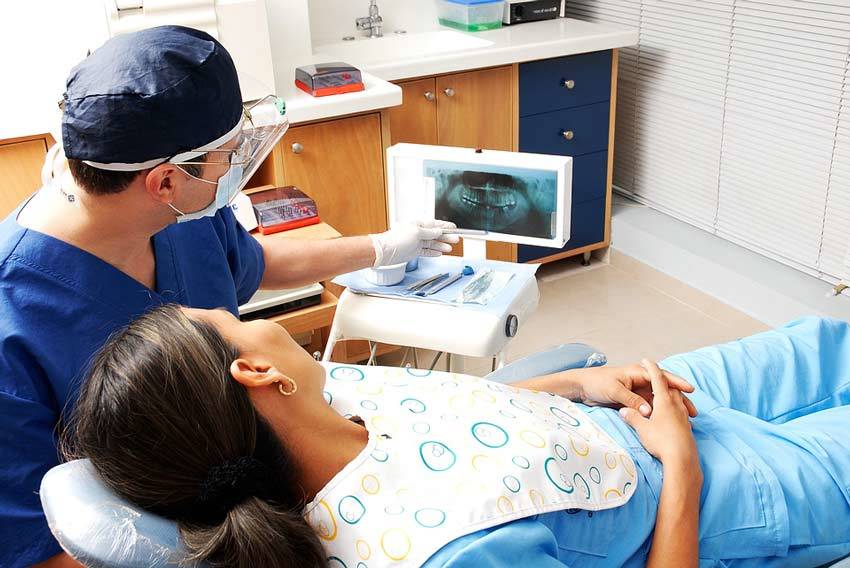Content
- What determines the shape of the eyes
- Eastern type
- Description and anatomy
- What nationalities do
- European
- Standard
- How to change
- Cantoplasty
- Cantopexy
- Blepharoplasty
- Oriental blepharoplasty
- Eye cut video
Eyelids and shape the eyes of different nations differ from each other. But some people are happy with it, while others are not. In total, there are 3 types of incisions of the human visual organs. They have their own characteristics and characteristics.
What determines the shape of the eyes
According to scientists, it is known that the shape of the eyes, like other features of peoples, is a kind of protection from an unfavorable environment and climate. So, European signs differ from Chinese ones, for example. Moreover, in people living in more favorable regions, the features of the eyes deviate to the classic, familiar form.
Eastern type
For the eastern (Mongoloid) type of eyes, the following are characteristic:
- high position of the brow arches;
- narrow incision;
- orbital fat surplus;
- absence or smoothness of supraorbital folds in the upper eyelid;
- thick eyelid skin;
- epicanthus (folds of skin in the inner corners of the eye);
- small orbits.
Description and anatomy
The following table shows the statistics on the presence of an Asian eye shape in people: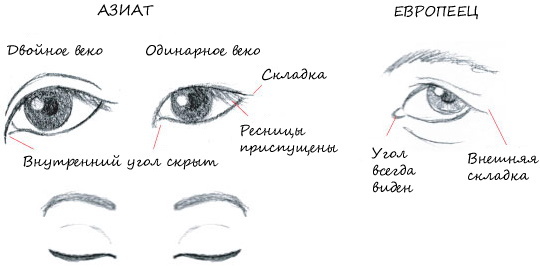
| Nationalities and races with an Asian eye shape | Percentage of population,% |
| Kyrgyz, Tomsk Tatars, Yakuts, Altai | About 66 |
| Natives of North, Central and East Asia | 60 |
| Kazakhs | 40 |
| Tobolsk Tatars | 39 |
| Nogays | 29 |
| Astrakhan Karagash | 14 |
What nationalities do
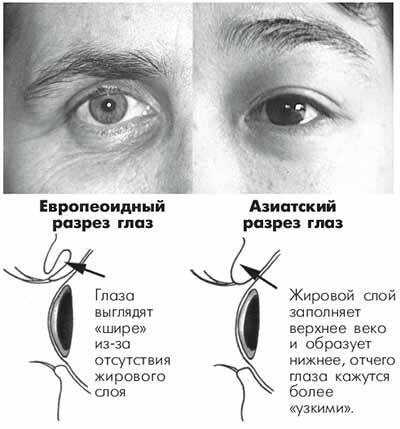
Asian eyelids are also found in:
- Sakhalin Oroks;
- Evenki;
- the Amur Negidalds;
- Yukaghirs;
- Buryats and Yakuts.
European
The European view is distinguished by the outer corners of the eye, which slope downward. Such eyelids can be found in 40% of the world's population. They are found among Europeans or Slavic nationalities.
Standard
The standard eye shape for makeup artists and plastic surgeons is considered ideal. Such forms are usually sought by those who do not have them. The corners of the visual organs, both internal and external, are located on 1 even eye line. They are neither raised nor lowered.
How to change
The desire to change the shape of the eyes through plastic surgery is characteristic mainly of Asian nationalities.
With such surgical interventions:
- tighten the eyelids;
- reduce their area;
- increase the shape of the visual organs.
The incision of a person's eyes (its types are described below), if you do not like it, can always be corrected with the help of modern plastic surgery. There are several methods for this in this medical industry. With their help, the shape of the visual organs changes forever and irrevocably.
Eyelid plastic surgery is usually used by people with:
- acquired deformities of the eye incision as a result of injury or burns;
- epicanthus or swollen upper eyelid;
- congenital incomplete cleavage of the eyelid;
- narrow eye slits;
- asymmetrical eyes;
- overhanging centuries;
- strongly convex or round optic organs;
- bags under the eyes.
Cantoplasty
With cantoplasty, the eye angles are changed. Performing such an operation, surgeons correct the lower and upper eyelids. Their lowering or raising is performed with the help of a tendon tightening. During this, the eyelids are detached from the cartilage and anchored at the optimum level. Before the intervention, the specialist marks the places for the new placement of the corners of the eyes.
Cantoplasty is performed for:
- improving the appearance of the face;
- following medical prescriptions;
- correcting aesthetic imperfections;
- rejuvenation.
Before cantoplasty, patients should visit:
- cardiologist;
- allergist;
- therapist.
The anesthesiologist or surgeon is informed about the identified allergy.
Before surgery:
- do not use blood thinners;
- do an ECG;
- take blood and urine tests;
- inform the doctor about the medications used.
Cantoplasty is contraindicated in people with:
- high intraocular pressure;
- endocrine pathologies;
- dry eye syndrome;
- progressive myopia;
- cardiovascular disease;
- oncology;
- poor blood clotting.
Cantoplasty lasts about 2 hours, it can be done at any age. The result after such a correction is quite long and attractive.
Cantoplasty is performed by a plastic surgeon as follows:
- Applying the markings previously discussed with the patient on the eyelids.
- Treatment of the operated areas with an antiseptic.
- Introduction of anesthesia.
- The product of a cut of the skin of the eyelids.
- Looseness or tension of the tendon through the resulting incision.
- Removal of excess fat and skin folds.
- Sewing up the wound and applying a bandage.
After cantoplasty, complications such as:
- eversion or non-closing of the eyelids;
- bleeding or scar dehiscence;
- hardening of the seams;
- wound infection;
- the appearance of skin pigmentation;
- irreversible asymmetry of the gaze.
Instead of cantoplasty, you can choose:
- hardware eyelid lift;
- thread lifting of the eye incision;
- blepharoplasty.

The advantages of cantoplasty are:
- change in the size and shape of the visual organs;
- getting rid of the asymmetry of the eyes;
- raising the inner cantus (corners) of the eyes;
- giving the skin elasticity and firmness;
- decreased pressure on the eyes;
- smoothing wrinkles;
- creating a lighter and more open look;
- getting rid of age-related swelling of the eyelids.
The disadvantages of the correction were:
- the need to change the lifestyle before and after surgery;
- existing contraindications;
- expensive price;
- the possibility of side effects;
- difficulty in choosing a specialist and a medical facility.
The cross-section of a person's eyes (its species are numbered only by 3 names) to some extent depends on the habitat of people. This trait is considered a genetically determined trait that is inherited in an autosomal dominant manner. It is also the result of ancient selective selection.
Cantopexy
The drooping eyelids or the outer corners of the eyes are raised with cantopexy.
But such a correction cannot be done to patients with:
- allergies;
- acute forms of disease;
- oncology;
- diabetes mellitus;
- exacerbated chronic diseases;
- thyrotoxicosis;
- cardiovascular complications;
- infections;
- blepharitis or conjunctivitis;
- glaucoma;
- fresh eye injuries;
- dry eye symptoms;
- neoplasms on the eyelids;
- myopia;
- exacerbated systemic lupus erythematosus;
- exfoliated retina.
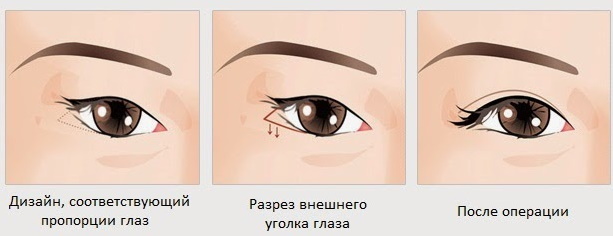
Cantopexy is done in an ophthalmological department or a clinical hospital. In front of her, patients are examined, and then sent to computer simulation. For lateral canthopexy, local anesthesia is used, and for medial canthopexy, general anesthesia is used.
In combination with cantopexy, they can also do:
- facial circular lift;
- medium lifting;
- blepharoplasty.
The rehabilitation period after the performed cantopexy usually lasts 0.5-1 months. Patients leave the operation for 3-7 days. Their eyelids become motionless at this time, and their vision decreases.
The skin may show:
- voltage;
- hyperemia;
- photosensitivity;
- swelling;
- redness;
- bruising.
By the end of the postoperative period, all eye functions return to normal.
During this time, doctors advise their patients not to:
- use cosmetics;
- work on computer;
- wear contact lenses;
- watch TV;
- do fitness;
- sleeping on your stomach;
- visit the sauna;
- to be on the street during the day without sunglasses.

After the operation, a thin, dense red suture is formed. In the future, he disappears, hiding in the fold of the eye. After 2 months. the eyelids are leveled, and the outer corners of the visual organs are raised. The results of cantopexy last for 5-10 years.
The cross-section of a person's eyes (its species over the centuries have been formed by sexual selection and genetic-automatic processes) is due to the racial identity of people. Adaptation and weather conditions are also added to this criterion. The type and shape of the visual organs also depend on the anatomical characteristics of the racial groups.
The advantages of cantopexy are:
- relatively affordable cost;
- not very pronounced invasiveness;
- long-lasting result;
- short postoperative period.
The disadvantages of corrective intervention include:
- incomplete disposal of pronounced aesthetic defects;
- complications after surgery;
- manifestation of keloid scars.
Blepharoplasty
Blepharoplasty (anesthesia is required for the operation) is done with pronounced:
- wrinkles;
- overhanging upper eyelids;
- bags under the eyes.
Oriental blepharoplasty (correction of the eastern eye section) can be:
- correcting;
- upper, with it, the epicanthus is excised and a double fold is created;
- circular, combining the lower and upper types of correction;
- lower, in which excess skin and adipocytic hernias are removed.

The operation is not performed for those who have:
- very large bags and swelling under the eyes;
- high cranial or blood pressure;
- infectious or acute diseases;
- malignant tumors;
- diabetes;
- diseases of the blood or thyroid gland.
Oriental blepharoplasty
The section of the human eye (its types during the entire time of human existence have undergone various and numerous mutations), especially if it is oriental, you can always change with the help of plastic to the side European. Surgeons call this operation "singapuri". It creates a supra-orbital site and removes the drooping eyelid. The look then becomes open and expressive.
Correction of Asian eyelids is subdivided into:
- age-related (suitable for elderly patients), during which the outer corners of the eyes are raised;
- natural, when the surgeon makes an incision, turning it into a fold in the upper eyelid at the inner corner of the eye;
- lunar, it is optimal for mixed nationalities;
- longitudinal.
Singapuri (oriental blepharoplasty) with incision-free suture should be performed as follows:
- Applying 1 mm punctures to the upper eyelid.
- Lifting the skin.
- Deep suture between the tendon and the skin to reinforce the crease that is being created.
- Final suturing and dressing.
The advantages of this method of performing an operation to correct the eastern eyelids include quick execution and no scarring.
The disadvantages are:
- the ability to perform only on thin skin and weakly expressed Mongoloid eyelids;
- palpable threads;
- impossibility of simultaneous removal of fat and skin.
With classic incisional singapuri, perform:
- Dissection on the natural crease of the eyelid.
- Disposal of hernias with resection of periorbital fat and soft tissues along the growth of eyelashes. This excision affects the depth of the formed skin fold.
- Cutting off muscles that are tightly attached to the eye.
- The connection of the edges of the tendon and wounds.
- Cosmetic stitching and dressing.
With this method, excessive eye skin density and ptosis are eliminated. Patients leave this operation for about 2 months. The surgical intervention itself lasts 1.5 hours.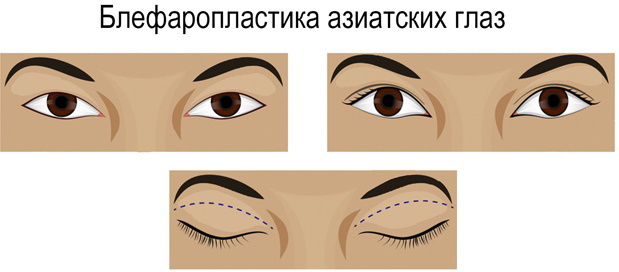
At the end of the operation, the eyelids are covered with aseptic dressings for 4 hours. In this case, analgesics are not necessary, since there is no severe pain after eyelid correction. The stitches are removed on the 5th day, and the bruises and swelling disappear on the 10th day.
After oriental blepharoplasty, when the doctor's recommendations are not followed in the postoperative period, the following phenomena are usually observed:
- curvature of the cartilage tissue of the eyelid;
- burning in the eyes;
- divergence of seams;
- dry eyes or tearing;
- minor swelling and inflammation;
- long tightening of scars;
- blepharoptosis;
- asymmetry of the eyes.
The eyes of people, especially their section, were formed under the influence of external environmental factors. The types of these signs of human races largely depend on the climate and other living conditions. A significant role in the creation of such distinctive features was played by centuries of evolution. Plastic surgery is always ready to correct its changes.
Specific side effects after correcting the eastern eye shape include:
- double vision due to muscle damage;
- a feeling of cramps and dryness in the eyes, which disappears on its own after 10 days;
- lacrimation due to disruption of the glandular ducts;
- tightening of the outer eye canthus, which is disposed of with the help of surgical intervention;
- the occurrence of conjunctivitis;
- dissection of the upper eyelid, requiring reoperation;
- eversion of the eyelids, which is eliminated with the help of a special massage.
After surgery on the eyelids, 2 weeks are required:
- visit a specialist;
- do not drink alcohol;
- avoid reading and being at the computer;
- do not strain physically;
- do not use cosmetics;
- constantly apply eye drops prescribed by a doctor;
- protect eyes from the sun;
- avoid eye infections and irritation.
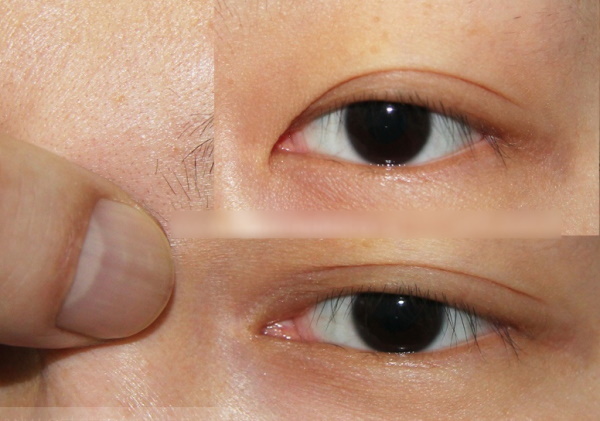
The advantages of laser blepharoplasty are:
- short postoperative rehabilitation;
- quite predictable outcome;
- fast execution (about 30 min.);
- instant healing without any traces.
In the formation of the European age, modern surgeons do not make long incisions. Due to this, the likelihood of scarring is significantly reduced. But if the scars do appear, then after a while they are removed with a laser.
For quick recovery after eyelid surgery, it is recommended:
- treatment of scars with antiseptic drugs, and after 7 days - with antibacterial creams with a softening effect;
- night rest on the back with the head resting on a high pillow;
- avoid excessive eye strain;
- exclusion of physical activity;
- avoid tilting the head forward or backward;
- adhere to a special diet;
- drinking plenty of clean water (at least 1.5 liters per day).
The effectiveness of the plastic correction of the eyelids is manifested:
- rejuvenated facial features;
- increased eye size;
- expressiveness and openness of sight;
- formed double folds on the upper eyelids;
- lack of overhanging eyelids;
- disappearance of wrinkles and bags under the eyes;
- the acquisition of new, clearer and more pleasant eye contours;
- complete absence of traces in the form of scars and scars.
The concept of an ideal eye shape does not exist at all. Often the section of the human visual organs is mixed. If someone is not satisfied with the look of their own eyes, then it can be corrected. This is done by plastic surgeons. Experts in this field offer an extensive number of methods for correcting shapes.
Eye cut video
The shape of the eyes will tell you everything about you:


